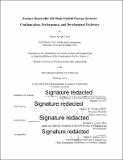Nuclear renewable oil shale hybrid energy systems : configuration, performance, and development pathways
Author(s)
Curtis, Daniel Joseph
DownloadFull printable version (12.86Mb)
Other Contributors
Massachusetts Institute of Technology. Department of Nuclear Science and Engineering.
Advisor
Charles W. Forsberg.
Terms of use
Metadata
Show full item recordAbstract
Nuclear Renewable Oil Shale Systems (NROSS) are a class of large Hybrid Energy Systems in which nuclear reactors provide the primary energy used to produce shale oil from kerogen deposits and also provide flexible, dispatchable electricity to the grid. Kerogen is solid organic matter trapped in sedimentary shale, and the formations of kerogen oil shale in the western United States are the largest and densest hydrocarbon resource on the planet. When heated above 300 °C, kerogen decomposes into oil, gas, and char. NROSS couples electricity and transportation fuel production in a single operation, reduces lifecycle carbon emissions from the fuel produced, improves economics for the nuclear plant, and enables a major shift toward a very-low-carbon electricity grid. The nuclear reactor driving an NROSS system would operate steadily at full power, providing steam for shale heating in closed steam lines when the price of electricity is low and electricity to the grid when the price of electricity is high. Because oil shale has low thermal conductivity, heat input to the shale can be cycled as needed without disrupting the steady increase in average temperature. The target average shale temperature of 350 °C would be reached over 2 years using two heating stages in the baseline configuration driven by light water reactors. First stage heating brings the shale to an intermediate temperature, assumed to be 210 °C in this study. The second heating stage isolates the steam delivery line from the reactor and uses electricity, purchased when prices are low, to increase steam temperature and bring the shale to 350 °C. This capacity to absorb low price electricity mitigates the tendency for electricity prices to collapse to zero, or potentially negative values, during periods of peak wind and solar output. The analysis herein shows that liquid fuels produced by a baseline NROSS would have the lowest life cycle greenhouse gas impact of any presently available fossil liquid fuels and that operation as part of an NROSS complex would increase reactor revenues by 41% over a stand-alone baseload reactor. The flexible, dispatchable electricity provided by NROSS could also enable the transition to a very-low-carbon grid in which renewables are widely deployed and the NROSS provides variable output to balance their uncontrolled output to meet demand. Fully deployed, NROSS could require tens or hundreds of reactors. Large fleet operations and local mass production of the necessary hardware could bring about substantial reductions in system cost as development proceeds, potentially offering a pathway to jump start and maximize the realization of the mass production cost savings envisioned for small modular reactors. The development pathway to achieve large scale NROSS deployment will be complicated, however, requiring involvement from many government agencies, a demonstration system, and a complex commercialization effort with partnered nuclear vendors, utilities, and petroleum system developers.
Description
Thesis: S.M., Massachusetts Institute of Technology, Department of Nuclear Science and Engineering, 2015. Cataloged from PDF version of thesis. Includes bibliographical references.
Date issued
2015Department
Massachusetts Institute of Technology. Department of Nuclear Science and EngineeringPublisher
Massachusetts Institute of Technology
Keywords
Nuclear Science and Engineering.